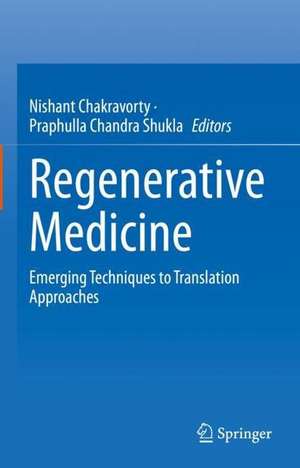Regenerative Medicine: Emerging Techniques to Translation Approaches
Editat de Nishant Chakravorty, Praphulla Chandra Shuklaen Limba Engleză Hardback – 31 ian 2023
| Toate formatele și edițiile | Preț | Express |
|---|---|---|
| Paperback (1) | 1222.01 lei 6-8 săpt. | |
| Springer Nature Singapore – feb 2024 | 1222.01 lei 6-8 săpt. | |
| Hardback (1) | 1228.15 lei 6-8 săpt. | |
| Springer Nature Singapore – 31 ian 2023 | 1228.15 lei 6-8 săpt. |
Preț: 1228.15 lei
Preț vechi: 1497.75 lei
-18% Nou
Puncte Express: 1842
Preț estimativ în valută:
235.08€ • 255.44$ • 197.60£
235.08€ • 255.44$ • 197.60£
Carte tipărită la comandă
Livrare economică 21 aprilie-05 mai
Preluare comenzi: 021 569.72.76
Specificații
ISBN-13: 9789811960079
ISBN-10: 9811960070
Pagini: 390
Ilustrații: XV, 390 p. 1 illus.
Dimensiuni: 155 x 235 mm
Greutate: 0.74 kg
Ediția:1st ed. 2023
Editura: Springer Nature Singapore
Colecția Springer
Locul publicării:Singapore, Singapore
ISBN-10: 9811960070
Pagini: 390
Ilustrații: XV, 390 p. 1 illus.
Dimensiuni: 155 x 235 mm
Greutate: 0.74 kg
Ediția:1st ed. 2023
Editura: Springer Nature Singapore
Colecția Springer
Locul publicării:Singapore, Singapore
Cuprins
Chapter 1. Regeneration and tissue microenvironment.- Chapter 2. Non stem cell mediated tissue regeneration and repair.- Chapter 3. Immunological Perspectives Involved in Tissue Engineering.- Chapter 4. Advances in Medical Imaging for Wound Repair and Regenerative Medicine.- Chapter 5. Role of Biosensors in Regenerative Therapeutics: Past, Present & Future Prospects.- Chapter 6. Acute and Chronic Wound Management: Assessment, Therapy and Monitoring Strategies.- Chapter 7. Stem cells and therapies in cardiac regeneration.- Chapter 8. Hydrogel-based Tissue-mimics for Vascular Regeneration and Tumor Angiogenesis.- Chapter 9. Advances in 3D Printing Technology for Tissue Engineering.- Chapter 10. Adult Neurogenesis: A Potential Target for Regenerative Medicine.- Chapter 11. Regenerative approaches in the nervous system.- Chapter 12. Prenatal interventions for the treatment of congenital disorders.- Chapter 13. Understanding LncRNAs in biomaterials development for osteointegration.- Chapter 14. Current approaches in vertical bone augmentation and large bone deficiencies in the oro-facial region.- Chapter 15. In-vitro and in-vivo tracking of cell-biomaterial interaction to monitor the process of bone regeneration.- Chapter 16. The Prospects of RNAs and Common Significant Pathways in Cancer Therapy and Regenerative Medicine.
Notă biografică
Dr. Nishant Chakravorty leads the Regenerative Medicine lab as a faculty member at the School of Medical Science and Technology, Indian Institute of Technology Kharagpur (India). He has earlier served as a Clinical Specialist with Philips India Ltd (2014-2015). Dr. Chakravorty is a physician-scientist by training (MBBS, Masters in Med. Sci. & Tech.) with a PhD from Queensland University of Technology (QUT), Australia (2014). His research interests involve utilization of the concepts of cellular and molecular biology, biomaterials and tissue engineering to study human pathophysiological conditions. He has several international research publications, book chapters, and conference presentations to his credit. He is an Editorial Board member of the journal Molecular Biology Reports and also serves as a reviewer for several international journals. Dr. Chakravorty is a selected Member of India’s one and only young science academy, Indian National Young Academy of Sciences (INYAS) and is an elected Member of Royal Society of Biology, UK. He is also the recipient of several awards notably, Outstanding Doctoral Thesis Award - Executive Dean’s Commendation Award for 2014 (Science and Engineering Faculty, QUT, Australia) and Institute Silver Medal, (IIT Kharagpur-2010). He is a Life Member of Indian Society of Hematology and Blood Transfusion, Bengal Society of Haematology (BSH), India and Eastern Haematology Group, India.
Dr Praphulla Chandra Shukla is a faculty of School of Medical Science and Technology, IIT Kharagpur. He was earlier associated with Charite´ Medical University Berlin, Germany (2014-2016), BITS Pilani, India (2012-2014), Whitaker Cardiovascular Institute, Boston University, Boston (2011-2012) and University of Toronto (2006-2011). His research interests are myocardial damage and regeneration, endothelial cells transformation, atherosclerosis, cardiomyocyte cell cycle and epigenetics. He has been selected for various fellowships and been the finalist for Young Investigator Awards from American College of Cardiology, American Heart Association. He has published more than 20 international peer-reviewed papers. He is also active member of various societies such as German Cardiac Society, Canadian and American Heart Association as well as American College of Cardiology.
Dr Praphulla Chandra Shukla is a faculty of School of Medical Science and Technology, IIT Kharagpur. He was earlier associated with Charite´ Medical University Berlin, Germany (2014-2016), BITS Pilani, India (2012-2014), Whitaker Cardiovascular Institute, Boston University, Boston (2011-2012) and University of Toronto (2006-2011). His research interests are myocardial damage and regeneration, endothelial cells transformation, atherosclerosis, cardiomyocyte cell cycle and epigenetics. He has been selected for various fellowships and been the finalist for Young Investigator Awards from American College of Cardiology, American Heart Association. He has published more than 20 international peer-reviewed papers. He is also active member of various societies such as German Cardiac Society, Canadian and American Heart Association as well as American College of Cardiology.
Textul de pe ultima copertă
This book focuses on the recent innovations and therapeutic potentials of regenerative medicine and discusses the applications of stem cells, biomaterials, and tissue engineering in regenerative medicine. The book covers essential aspects of regenerative medicine, including tissue microenvironment, immunological perspectives, stem, and non-stem cell-mediated approaches, imaging techniques, biomarkers, and 3D printing technology. It also reviews the applications of biosensing technologies in regenerative medicine, including biomanufacturing, organ-on-a-chip technologies, and as indicators of therapeutic efficacy. Further, it focuses on the regenerative medicine approaches for diseases of the central nervous system. It also provides the therapeutic potential of regenerative medicine to improve soft tissue and wound healing, cardiovascular, neural, bone, and orofacial regeneration.
Caracteristici
Discusses therapeutic potentials of regenerative medicine Presents regenerative approaches for diseases of the central nervous system Review’s role of biosensors and biomarkers in regenerative medicine
